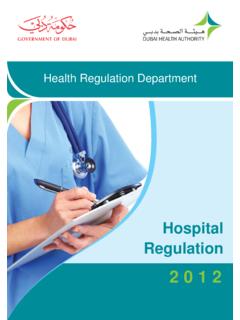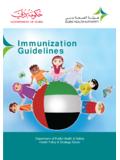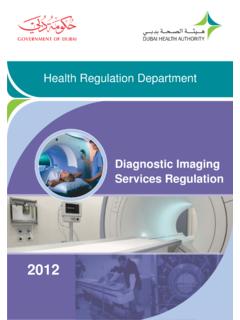Transcription of National Guidelines for Clinical Management and Treatment ...
1 National Guidelines for Clinical Management and Treatment of covid -19 (Version 2- April, 4th 2020) Page 1 of 51 National Guidelines for Clinical Management and Treatment of covid -19 April 3rd, 2020 Version 2 Prepared and Reviewed by National committee for Management of covid -19 Cases Approved by Technical team for Pandemic Control National Guidelines for Clinical Management and Treatment of covid -19 (Version 2- April, 4th 2020) Page 2 of 51 Contents Page No. Objectives 4 Introduction to Coronaviruses (CoV) 4 Case Definition 4 Clinical Findings and Complications 5 Baseline Investigations -Chemistry and Haematology - Microbiology - Radiology 5,6 Requesting COVID19 PCR test 7 Transport of Respiratory Secretions Samples 7 Medical Care for Patients with COVID19 infection 7 Dealing with Patients attending to Primary Health Care (PHC) or Accident and Emergency (AE)
2 8 Clinical Management and Treatment for confirmed covid 19 cases -Possible Therapeutics options -Laboratory And Radiology Monitoring -ECG Monitoring 9 9 9 10 Treatment options 11 Table 1: Proposed Therapeutic Regimens for Adults 11 Suspected cases qualifying for possible therapy 11 Camostat Mesylate 13 Azithromycin 14 Remdesivir 14 Tocilizumab Protocol for severely ill ICU patients with covid -19 Pneumonia 15 Pediatric Patients covid -19 Treatment options 16 Pregnant patient 20 Medication Saftey 20 Discharge Criteria 22 Infection Control Measures for Suspected Or Confirmed COVID19 Cases In Healthcare Facilities 22 Early Recognition covid 19 Visual Triage Form 22 Infection Control Practices In Healthcare Facilities Training General recommendations.
3 -Implement Standard Precautions for all patients at all times Practice Airborne, droplet and contact Precaution when dealing with Suspected/Confirmed Cases Personal Protective Equipment (PPE) for suspected or confirmed cases of covid 19 Patient Care Equipment Patient Transport in the hospital Patient Transport to another facility Additional Measures 23 24 25 Environmental cleaning in isolation rooms/areas 26 Linen and laundry Management , food service utensils and waste Management , related to COVID19 case 26 Managing Suspected /Confirmed case in Operation Theater 27 National Guidelines for Clinical Management and Treatment of covid -19 (Version 2- April, 4th 2020)
4 Page 3 of 51 Managing bodies in the Mortuary 28 Surveillance 29 Surge capacity 29 Occupational Health for Healthcare workers 30 Flowchart on the Management of Healthcare Workers Exposure to covid 19 36 References 37 Appendix 1:Proper Use of PPE 38 Appendix II: Patient under Investigation (PUI) Form 43 Appendix III: Informed consent to Treatment with INVESTIGATIONAL medication- English &Arabic 46 Appendix IV: Informed consent to Treatment with OFF-LABEL medications- English &Arabic 48 Appendix V: Home Quarantine Consent- English &Arabic 50 Appendix VI: Instructions for HOME Quarantine for ( covid -19) - English &Arabic 51 National Guidelines for Clinical Management and Treatment of covid -19 (Version 2- April, 4th 2020) Page 4 of 51 Objectives The objectives of this document are.
5 To provide guidance on Clinical Management of the covid -19 infection To provide a protocol on the practical steps to deal with covid -19 cases To detail the measures necessary to protect hospital staff, patients and visitors This guideline is not intended to override the Clinical decisions that will be made by clinicians providing individualized patient care. This guideline will be updated as more information becomes available. Introduction to Coronaviruses (CoV) Corona virus is a large family of viruses that cause illness in humans and animals In people, Corona virus can cause illness ranging in severity from the common cold to Pneumonia and Severe Acute Respiratory Illness Corona virus is one of seven types of known human coronaviruses.
6 SARS COV2 like the MERS and SARS coronaviruses, likely evolved from a virus previously found in animals The estimated incubation period is unknown and currently considered to be up to 14 days post exposure. Case Definition: Suspected covid -19 case is defined as: 1. Please refer to the local health authority websites for updated information on local case definition. MOHAP, DoH, SEHA and DHA Confirmed covid -19 is defined as: A person with confirmed positive covid -19 test positive (SARS COV2 PCR) by an approved laboratory. National Guidelines for Clinical Management and Treatment of covid -19 (Version 2- April, 4th 2020) Page 5 of 51 Clinical Findings and Complications Some patients with initially mild symptoms may progress over the course 5-7 days from symptom onset.
7 Clinical Symptoms: Signs and symptoms include: Fever Cough Myalgia or fatigue Shortness of breath Sore throat Runny nose Diarrhoea and nausea Muscle ache Headache Pneumonia and ARDS Loss of sense of smell Renal failure, pericarditis and Disseminated Intravascular Coagulation Complications: Severe Pneumonia Acute Respiratory Failure and ARDS Acute Renal failure Disseminated intravascular coagulation Sepsis or septic shock High-risk group Age above 60 years old Smoker Cardiovascular disease Diabetes Hypertension Immune deficiency and or suppression ( HIV/AIDS, long-term steroid therapy, post- transplant cases, chemotherapy, immune modulator therapy) Pre-existing pulmonary disease ( uncontrolled Asthma, COPD, bronchiectasis) Other chronic disease such as chronic kidney disease, Chronic Respiratory disease, Sickle Baseline Investigations Chemistry and Haematology: 1.
8 Complete blood count and differential 2. Renal function and Electrolytes 3. Serum Glucose (HbA1C if diabetic) 4. Liver Function test including Liver enzymes National Guidelines for Clinical Management and Treatment of covid -19 (Version 2- April, 4th 2020) Page 6 of 51 5. CRP 6. procalcitonin 7. G6PD (if Treatment with chloroquine is being considered) 8. LDH 9. Coagulation profile 10. Ferritin 11. D-dimer 12. Troponin & creatinine kinase (CK) 13. HIV Ag/Ab 14. Pregnancy test in women of child-bearing age Microbiology: SARS COV2 PCR on following samples 1. Deep respiratory samples (sputum or deep tracheal aspirate) if lower respiratory tract infection 2.
9 Nasopharyngeal Aspirate/Swab and oropharyngeal swab (should use non-cotton flocked swab) if upper respiratory tract infection Staff should be trained on Sample collection. 3. For intubated patients, obtain deep tracheal aspirate for: a) SARS-CoV2 PCR b) Atypical PCR panel if available (Mycoplasma, chlamydia, legionella) c) Respiratory viral panel d) Other investigations to consider if the aetiology of the severe pneumonia is not identified: urinary antigen titres stain/culture Tuberculosis culture and PCR pathogens in immunocompromised patients All specimens should be regarded as potentially infectious, and HCWs who collect, or transport Clinical specimens should adhere rigorously to standard precautions to minimize the possibility of exposure to pathogens.
10 Radiology Ensure infection control measure are takes if patient is transferred to radiology or any other department outside the isolation room 1. CXR 2. Chest CT scan (HRCT or non-contrasted CT scan) is mandatory for all high-risk group patients admitted to hospitals and for patients with rapidly progressing illness. Consider CT scan chest while waiting CVOID19 PCR report as a diagnostic modality to guide early Treatment and in patients with Clinical features of pneumonia and normal chest X ray. National Guidelines for Clinical Management and Treatment of covid -19 (Version 2- April, 4th 2020) Page 7 of 51 (when mobilising patient ensure infection control measures are followed during and after transport) Cardiac investigations: 3.










